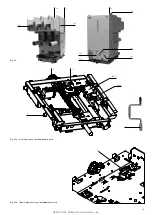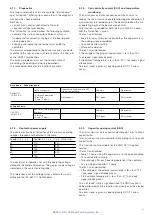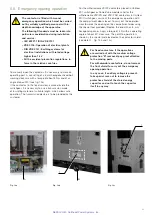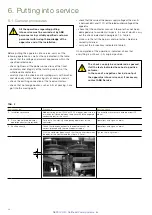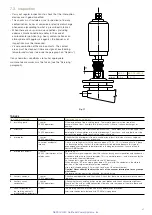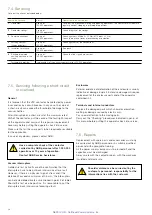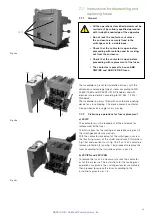
43
60
61
61
7.10. Putting the contactor back into
service
7.10.1. Mounting the shield and insulating guard (fig. 18)
Reposition the protection (1) (fig. 18b), repeating the
operations indicated in par. 7.7.2. in reverse order.
Remount the shield. Check that the impulse counter (14) (fig.
18c) inserts itself into the special seat (69) (fig. 18d) and fix the
shield with the screws (70) and DIN washers (71) (fig. 18a).
7.10.2. Checking apparatus functions
Rack the contactor into the enclosure, working as indicated in
par. 6.
In the “isolated for test” position, check the correctness and
functionality of the contactor “open/closed” signalling by
carrying out a few operations.
7.11. Checking the degree of vacuum of
the interrupter
This test is not required for normal maintenance. Should
it become necessary for extraordinary maintenance, carry
out the test on the interrupter without dismantling it from
the contactor and use the VIDAR tester, of the Programma
Electric GmbH, Bad Homberg v.d.H. company, for the
vacuum test.
To check the vacuum air tightness of the interrupter, prepare
the following VIDAR tester test values:
Contactor rated voltage
DC test voltage
7.2 kV
16 kV
12 kV
22.5 kV
The test must always be carried out with the contactor open,
with the contacts at the nominal distance.
Procedure for testing the vacuum of the interrupter of the
contactor poles:
– turn off the power and make the working area safe according
to the safety regulations of the IEC/DIN VDE standards;
– open the contactor;
– ground a terminal of each contactor pole;
– connect the ground terminal of the VIDAR tester to the
structure of the contactor (grounding point of the contactor);
– connect the high voltage terminal of the VIDAR tester to
the terminal not connected to ground of the contactor
pole (phase L1) and carry out the test. Repeat the test for
phases L2 and L3.
The tester connection cables can produce
an indication due to capacitive effect. In this
case, the cables must not be removed.
Fig. 21
7.9. Mounting and dismantling the
short-circuit busbar
a) Mounting (fig. 21)
Mount the busbar with the feeler pin (60) on the opposite side
to that of the tulips and fix it with the screws (61).
b) Dismantling (fig. 21)
To dismantle, proceed in reverse order.
The same instructions are given in the Kit sheet put in the
short-circuit busbar packing.
NEPSI.COM - Northeast Power Systems. Inc.

